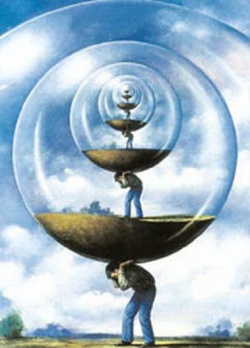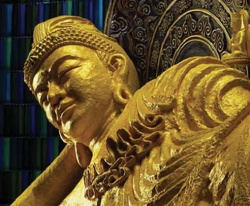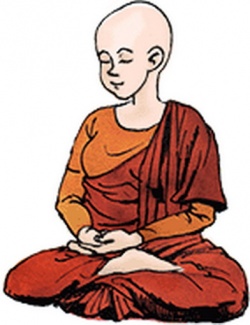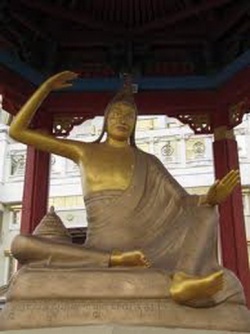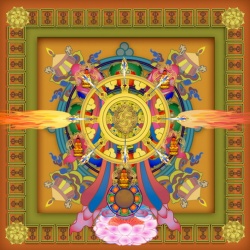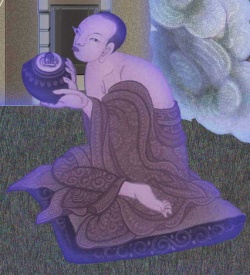Digha Nikaya, Sutta 33: The Compilation. Sevens
Digha Nikaya
Sutta 33
Saṅgīti-Suttanta
The Compilation
Sevens
Translated from the Pali by Michael Olds
There are, friends, seven-part Dhammas consummately taught by the Bhagava, that #1-Consummately-Awakened-One, an Arahant who knows and sees. In this situation, let us allgather together as one, undivided, so that this Best of Lives will stay on track and stand for a long time as a benefit to the many, as a pleasure for the many, out of compassion for the world, for the benefit and pleasure of gods and man.
What are these sevens?
Seven Aristocratic Treasures:[1]
The faith-treasure, the ethics-treasure, the sense-of-shame-treasure, the fear-of-blame-treasure, the knowledge-threasure,[2] the generosity-treasure, the wisdom-treasure.
The Seven Dimensions of Self-Awakening:[3]
The mental dimension of self-awakening, the Dhamma-research dimension of self-awakening, the energizing dimension of self-awakening, the impassivity dimension of self-awakening, the getting high dimension of self-awakening, the objective detachment dimension of self awakening.
Seven requisites of getting high:[4]
High view, high principles, high speech, high works, high lifestyle, high self-control, high mindedness.
Seven that are not True Dhamma:[5]
Here friends a beggar is without faith, without sense of shame, without fear of blame, is of little learning, is lazy, is absent-minded, lacking in wisdom.
Seven that are True Dhamma:[6]
Here friends a beggar has faith, has a sense of shame, has fear of blame, has heard much, is enterprising and energetic, is wise.
Seven Dhammas of a Good Man:[7]
Here friends a beggar has knowledge of Dhamma, knowledge of the goal, has knowledge of the self, has knowledge of measure, has knowledge of timing[8], knowledge of classes of men, knowledge of individuals.
Seven characteristics of distinction:[9]
Here friends a beggar has a great desire to undertake training, and likes the workout[10] undertaking the training involves.
He has a great desire to get down the dhamma and likes the workout getting down the dhamma involves.
He has a great desire to control his wishes and likes the workout controlling his wishes involves.
He has a great desire for retirement in seclusion and likes the workout retirement in seclusion involves.
He has a great desire for arousing of energy and likes the workout arousing energy involves.
He has a great desire for mental discipline and likes the workout mental discipline involves.
He has a great desire for penetrting view and likes the workout penetrating view involves.
Seven perceptions:[11]
Perception of impermanance, perception of not-self, perception of the impure, perception of misery, perception of letting go, perception of dispassion, perception of ending.
Seven powers:[12]
Faith-power, energy power, sense-of-shame-power, fear-of-blame-power, mental-power, high-getting-power, wisdom-power.
Seven footholds of consciousness:[13]
There are beings, friends, diverse in body, diverse in perception suchas man, some gods and some on the path to ruin. This is the first foothold of consciousness.
There are beings, friends, diverse in body, similar in perception, such as the gods in the Brahma group.[14] This is the second foothold of consciousness.
There are beings, friends, similar in body, diverse in perception, suchas the gods of the Abhassara. This is the third foothold of consciousness.
There are beings, friends, similar in body and similar in perception, such as the gods of the Subhakiṇhā. This is the fourth foothold of consciousness.
There are beings, friends that, passing past all perception of materiality, leaving behind perception of reaction,[15] averting the mind from perception of diversity, thinking 'Unending is space,' experience the Realm of Space.[16] This is the fifth foothold of consciousness.
There are beings, friends that, wholly passing past the Realm of Space, thinking "Unending is Consciousness,' experience the Realm of Consciousness. This is the sixth foothold of consciousness.
There are beings, friends that, wholly passing past the Realm of Consciousness, thinking 'There are No Things There,' experience the Realm Where There is No Thing There.[17] This is the seventh foothold of consciousness.
Seven individuals worthy of receivings:[18]
Both-sides-freed, wisdom-freed, the body-seer, the liberated-at-heart, the Dhamma-follower, the faith follower.
Seven biases:[19]
The bias towards lust for sense pleasures, the bias towards reaction, the bias towards views, the bias towards doubt, the bias towards pride, the bias towards lust for living, the bias towards blindness.
Seven yokes to rebirth:[20]
The yoke to rebirth which is compliance, the yoke to rebirth which is reaction, the yoke to rebirth which is views, the yoke to rebirth with is doubt, the yoke to rebirth which is pride, the yoke to rebirth which is lust for living, the yoke to rebirth which is blindness.
Seven that calm and settle disputatious disrupting-eruptions:[21]
Setting up discipline by confrontation,
Setting up discipline by reminder,
Setting up discipline of the deranged,
Allowing rehabilitation after admission of guilt,
Settling disputes by majority rule,
Sanctioning evil-doers,
Settling an issue by burying it, covering it as with a grass garment.
These then, friends, are those seven-part Dhammas consummately taught by the Bhagava, that #1-Consummately-Awakened-One, an Arahant who knows and sees. In this situation, let us all gather to gether as one, undivided, so that this Best of Lives will stay on track and stand for a long time as a benefit to the many, as a pleasure for the many, out of compassion for the world, for the benefit and pleasure of gods and man.
Footnotes
[1] Satta ariya-dhanāni.
[2] Suta: "hearing"; usually stated as one who has heard much, who knows the suttas by heart, who knows the vinaya by heart. Ananda was the foremost among those who had "heard much." The meaning is one who has very wide book-knowledge, but who may or may not also have vision and wisdom.
[3] Satta sabbojjhaŋgā. See Glossology: Satta Sambbojjhanga and The Seventh Lesson
[4] Satta samādhi-parikkhārā. PED: Parikkhāra "all that belongs to anything," make-up, adornment (a) requisite, accessory, equipment, utensil, apparatus ... (b) In a special sense and in very early use it refers to the "set of necessaries" of a Buddhist monk and comprises the 4 indispensable instruments of a mendicant, enumd in stock phrase "cīvara-piṇḍapāta-senāsana-gilānapaccayabhesajja-p." i. e. robe, alms-bowl, seat and bed, medicine as help in illness. How many of you made "robes" as I suggested at one time? Those of you who are interested in magic powers should closely examine these "requisites." There are those who use magic wands, and sticks and a million other tricks to focus magic power. Here the bhikkhus who are so inclined use these requisites. The great power of these requisites lies in their multiple levels of symbolism. On the surface they are basic necessities of life as a homeless person, but on a deeper level they encompass all the various areas of "possessions" in the world. This is why (see above, #4.20: Sources of Desire) arguments between bhikkhus often center around robe material or bowls. Where the ordinary person here today (Friday, September 20, 2002, USA) has his house, and car and big-screen tv and custom-made computer and stock portfolio and uses these things to support his feelings of self-esteem and his judgment of his own success and worth and the way he imagines he is able, because of these things to relate to others, when the bhikkhu has reduced down his possessions to these minimum items, all his personal power gets focused through them. On the one hand that power is vastly more potent; like a lazer beam compared to a bunch of candles; on the other hand it can also be a great source of danger to one untrained in ethical culture and self control in that, say, if one goes berzerk because someone has touched one's bowl, one quickly ends up as an ordinary man and is in the end, going nutz over a bowl — a bit of dirt, iron or clay, formed in a certain shape — , and probably a old, uselsss, damaged one at that. A beggar, beggars, is not overly protective of his bowl, neither is he neglectful. The fewer the requisites the more potant, so that those who are content with just their one set of robes and bowl are very powerful indeed. Others call themselves: "Any bowl-men" "Any robe-men" showing disdain for magic powers, able, if such things are called for, to accomplish the same thing without need of a material focusing device — they use such requisites as are the subject of this section of this sutta. This last is the highest and best. Now imagine the case of some person here starting out interested in magic powers, but who has an idea that the Buddha may have the solution to many more issues than just simply attaining powers. He imitates this highest attitude and while others concentrate their efforts on finding their hands in their dreams, he practices generosity, cultivates ethical behavior and self control, mental culture and letting go. In the end imagine that he has failed utterly at attaining his original goal of magic powers as will be the case in 99 out of 100 cases of those who set out to attain magic powers. Of the two practices the one who follows the method set out in this system will end up with great gains in all aspects of his ordinary life while those who have failed at the other methods will have nothing. Look to the end of the game, my friends, practice geneosity here and now, practice ethical culture, self discipline, mental development and letting go here and now. My say! For these see also: The Eighth Lesson, The 10th Lesson, High Getting High, and Glossology: The Atthangika Magga. One more thing: notice how this is a creative use of the Atthangika Magga, not stuck in some rigid box limited to the one way it is normally seen. One is to develop one's comprehension of the dhamma and it's units in such a way as this in order to be able to adapt them to any circumstances that present themselves.
[5] Satta asaddhammā. Kusīta. indolent, inert, inactive. Muṭṭha. having forgotten, one who forgets; forgetfulness, lit. forgotten-mindedness. Duppañño.: dupid; dats thupid, stupid!
[6] Satta saddhammā.
[7] Satta sappurisa-dhammā.
[8] Kala: which can be time which is how Walshe and Rhys Davids hear it. It can also be "dark" and this is the first meaning. "Knowledge of evil," which is something a good man might need to know.
[9] Satata niddasa-vatthūni. Niddesa 1. description, attribute, distinction; -vatthu object of distinction or praise. - 2. descriptive exposition, analytic explanation by way of question and answer, interpretation, exegesis. samādāne: see also: 4.24.
[10] Āyatiñ: stretch, reach, essentially what an athlete feels in the body after a special effort
[11] Satta saññā. See also 6s #22
[12] Satta balāni.
[13] Satta viññāṇa-ṭṭhitiyo. There are beings, friends that, wholly passing past the Realm of Consciousness, thinking 'There is Nothing There,' experience the Realm Where There is Nothing There. This is the seventh foothold of consciousness. An interesting variation on the idea in the 9 habitats of beings, this being a viewpoint taken from within...the perceptions of such beings, as opposed to a description of such beings. Vinipāta ruin, destruction; a place of suffering, state of punishment. The sotāpanna is called "avinipāta-dhammo," i. e. not liable to be punished in purgatory. Nipāteti to let fall, throw down into ... bring to fall, injure; fig. cast upon, charge with ... Pāteti 1. to make fall, drop, throw off. - 2. to bring to fall. - 3. to kill, destroy, cut off (the head). To > Latin: peto to go, im-pet-us, pedal, my guess to pada, pathwalk.
[14] paṭhamābhinibbattā: Walshe ignores this, Rhys Davids has: "reborn there from (practice here of) first (jhana). Lit: first-upon-reborn-there. It is stated in the commentaries that one is reborn from practice of the first jhana. This term may refer to this; if not, I have no idea what it means.
[15] Paṭigha 1. (ethically) repulsion, repugnance, anger. - 2. (psychologically) sensory reaction. I wonder if this is not, for the older, arupajhana system, the equivalent of vicara? This would not sit well for those who put the arupajhanas above the four jhanas (and, indeed, for the most part these four are given as following the four jhanas). My reason for suggesting that they are "at a level with" the fourth jhana is based on the fact that in many places these jhanas are left out altogether in the sequence needed to attain Arahantship, and because the concept of Upekkha (the fundamental state making up the fourth jhana) as I understand it as "detachment", at it's highest, encompasses everything and is a synonym for Nibbāna.
[16] Here again Rhys Davids inserts "infinite space in the name, and here also adds that they are "dwellers in." But the real value of this passage is that it is constructed differently than other descriptions of these jhanas. Here there is no "and he lives there" in this, this whole sequence is describing things from the viewpoint of the experiencer.
[17] I am again going to suggest that what the arupajhana series is all about is an older system of jhanas which was incorporated into the Buddhist system and that Akincana represented, probably at one time, a concept of Nibbāna (This is no great stretch; if you look at the names of the Arupa spheres each of them looks to have been, at one time, some kind of conception of the highest attainable sphere). This would have been understood as without the asavas (which themselves would have undergone a similar evolution). This would then present a problem in terms of it's position in a sequence where the only position without the asavas is to be Nibbāna. The little joke of my teachers begins to make sense: "I nearly got there today! Where? The Sphere that isn't there." So how can we craft a meaning for this term? I suggest the meaning is: 'No Thing There,' where it is not a matter of perceiving "nothing," but of perceiving that there is no substance to the things we do perceive. A sort of anatta with regard to phenomena other than just the self, except in this sphere it is not a matter of believing or not believing in a substantiative entity because the perception there is directly of the elemental nature of everything: you see a table but you also see it (not think it, or imagine it) is just an image made up of visible particles. Kiñcana only in neg. sentences: something, anything. From the freq. context in the older texts it has assumed the moral implication of something that sticks or adheres to the character of a man, and which he must get rid of, if he wants to attain to a higher moral condition. Def. as the 3 impurities of character (rāga, dosa, moha) ...
[18] Satta puggalā dakkhiṇeyyo. Dakkhiṇeyya one worthy of a dakkhiṇā receiving. -aggi the (holy) fire of a good receiver of gifts; a metaphor taken from the brahmanic rite of sacrifice, as one of the 7 fires (=duties) to be kept up (or discarded) by a follower of the Buddha; -khetta the fruitful soil of a worthy recipient of a gift; -puggala an individual deserving a donation; -sampatti the blessing of finding a worthy object for a dakkhiṇā. Bhāga 1. part, portion, fraction, share. - 2. apportioned share (of money), fee, remuneration. - 3. division of space, quarter, side, place, region. - fig. way, respect, in ubhato-bhāga-vimutta "free in both ways" (see Dial II.70; i. e. free both by insight and by the intellectual discipline of the 8 stages of Deliverance, the aṭṭha vimokkhā). - 4. division of time, time. See also: The Seven Types of Individuals
[19] Satta anusayā.
[20] Satta saṃyojanāni. Anunaya "leading along", friendliness, courtesy, falling in with, fawning. Opposite of paṭigha, where I follow Walshe in using "compliance" rather than non-reaction. See also: Saṃyojanāni The Ten Fundamental Attachments; and DN 3.19, DN 5.7.
[21] Satta adhikaraṇa-samathā uppannuppannānaṃ adhikaraṇānaṃ samathāya vūpasamāya. These make little or no sense without their context in the Vinaya; but here they are and they should stand on their own without that context in this context, so I have interpreted according to my best understanding in order to render these as rules that may be helpful in the calming down of disruptive situations of all sorts. Here is a more literal translation:
Seven that calm and settle the arising and re-arising of disputation:
Handing down discipline while facing,
Handing down discipline mentally,
Handing down discipline to the foolish,
Rehabilitation after admission,
According to the majority,
Sanctioning the evil-doer
Sheltering as with a grass garment.
Continue Reading
- Digha Nikaya, Sutta 33: The Compilation. Ones and Twos
- Digha Nikaya, Sutta 33: The Compilation. Threes
- Digha Nikaya, Sutta 33: The Compilation. Fours
- Digha Nikaya, Sutta 33: The Compilation. Fives
- Digha Nikaya, Sutta 33: The Compilation. Sixes
- Digha Nikaya, Sutta 33: The Compilation. Sevens
- Digha Nikaya, Sutta 33: The Compilation. Eights
- Digha Nikaya, Sutta 33: The Compilation. Nines
- Digha Nikaya, Sutta 33: The Compilation. Tens
